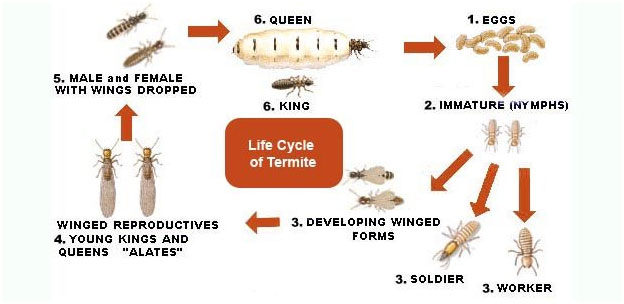Termite generally damage wooden articles like doors, window, bed, wardrobe etc. Termite eats wood and other cellulose items like paper etc. So they treat wood as their food and damage wooden items by eating. According to many studies termites damage billions of rupee wooden and other articles in . Thus you can imagine how dangerous termites could be if they are present in your premise.
It is very difficult to detect termites in home because they reside mostly in the soil and deep inside the wall. Once they make any major damage then only it can be detected generally.
If you pay attention on small things around the house, then it can be detected easily like if you find swarmers on window sill and other place, there could be termite in your premise. Also if you find wings of swarmers around or inside house you should be alert about termites.
If you find damaged wood or hollow wooden articles in your house or when you hear thudding sound on beating wooden articles, it is clear indication of termite presence there in house.
Once termite is detected in your compound you should hire termite treatment service in India for get free of termites. We at Termites Control Service have association with well experienced Pest Control Company and experts in India who are well trained in Termite Treatment in India.
There are certain Points to take care once termite treatment in India has been done like maintain proper cleanliness in house, keep away all unwanted clothes and wooden things from home, wooden articles should not be in contact with soil etc.
There are many steps in Termite Treatment in India like –
Soil Treatment in which we treat soil by injecting anti-termite chemical and ensure safety from termites.
Wooden Anti-Termite Treatment to ensure that your wooden articles remain safe from termites.
Foundation Treatment – This treatment is done before construction of house. This process of termite control is also known as pre-construction termite treatment service in India. This process of termite treatment in India ensures safety from beginning and also ensures no damage due to termites. If there are no termites in the soil, there is no chance for them to infect any wooden articles, thus 100% safety from termites.
Pre-Construction Termite Treatment in India is quiet effective method to get rid of termites without further damage of wooden items like doors, window, wardrobes, bed etc.
You will notice winged termites, called swarmers, after your home has received a thorough termiticide application. This can be a normal occurrence due to the biology of these insects.
Subterranean termites require food and water to survive. These termites feed on wood and plant products, such as paper, particleboard and fabrics. Subterranean termites generally obtain their water from the soil. They live in colonies that can contain many thousands of individual termites.
These colonies are composed of distinct casts or classes, workers, soldiers and reproductives. As their names indicate, each class of termites has unique responsibilities within the colony. Workers move between your home and soil throughout each day to collect food and water for the colony. Soldiers protect the colony from dangerous intruders, such as ants. Swarmers are winged reproductives which leave the colony to begin new colonies. Allied Exterminators will use a termiticide or bait system to create a protective barrier between your home and the soil.
Termite workers moving between your home and the soil will contact this barrier and die. Thus, workers will be unable to bring water back to the other termites, such as swarmers, which may be in your home. Eventually, all termites in your home will die, either by contact with the treated soil, or by lack of water.
The length of time for this to occur depends upon temperature, humidity, size of the termite colony and other conditions. Should you find termites swarming indoors after the termiticide barrier is applied, do not feel that the treatment was unsuccessful. Swarmers may be leaving the colony due to adverse conditions, such as lack of water and termite mortality, resulting from an effective termiticide treatment.Swarmers may use an existing mud tube, which workers abandoned after proper treatment, to leave the colony. Reproductives may also move through treated soil.Since reproductives move through the soil very quickly, they absorb less insecticide and are thus able to exit treated soil to swarm.
Reproductives will die soon after they leave the soil either naturally or by the insecticide which they contacted as they moved though the soil. Fortunately swarmers are not capable of constructing mud tubes or causing structural damage to wood. They merely indicate the colony is active in the area.
The presence of swarming ants or flying termites does not necessarily indicate that workers are still feeding on wood in the structure nor does it mean that an improper treatment was performed.
In any case a thorough inspection should be performed after the observation of swarmers or winged ants to discover if there are active workers which may have found an untreated gap in the soil barrier. A spot treatment at that location may be needed if active workers are present.
Alternatively, a structural problem may exist which permits termites to avoid contacting the termiticide treated soil.
For example, subterranean termite colonies can survive above ground with no soil contact if a sufficient water source is available within the structure.
Leaking roofs, bathtubs, showers, dishwashers and plumbing can be sources of water for termites.
Keep your pest control professional informed of your situation. With their expertise and your cooperation your valued property will be protected.
Termites hatch from eggs and can go through several life stages to reach maturity. Each termite egg can develop into any member of the termite caste – worker, soldier or reproductive. To make sure the colony has the right balance of termites fulfilling each role, the king and/or queen termite will produce pheromones to control the development of immature termites.

Have Any Question!